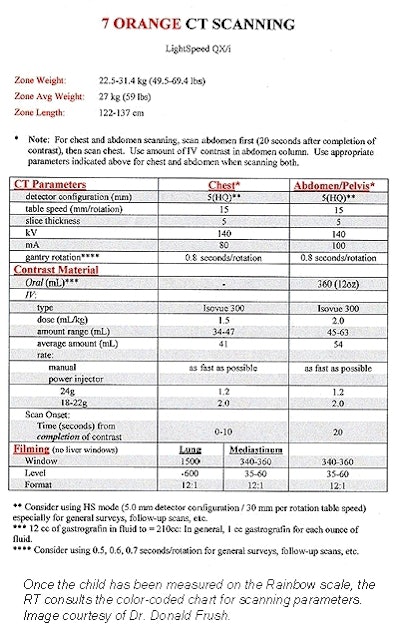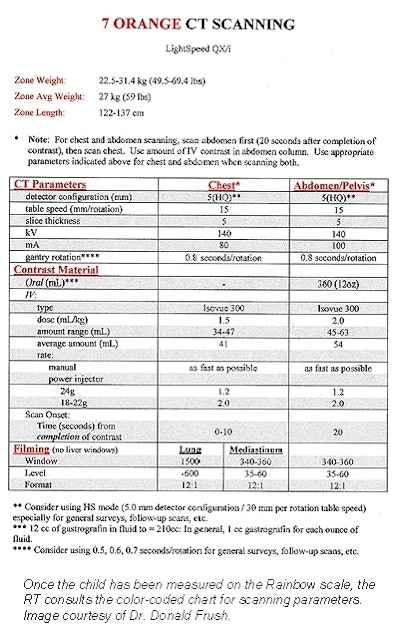
Colors play a major role in dictating human behavior. Red means stop, green means go, and orange means a detector configuration of 5 mm, slice thickness of 5 mm, and 1.5 ml/kg of contrast agent. It does, that is, if you are following "Rainbow Radiology," a color-coded system designed to streamline pediatric CT scans.
The result is a simple and consistent format for CT protocols that can reduce serious errors, including excessive radiation exposure in children, according to Dr. Donald Frush and colleagues from the Duke University Medical Center in Durham, NC. In a presentation at the 2001 American Roentgen Ray Society meeting in Seattle, study co-author and medical student Britt Soden said the system was well received by imaging staff during a six-week trial period at their institution.
Rainbow Radiology is based on the Broselow-Luten system developed by Dr. James Broselow and Dr. Robert Luten in the mid-1980s. The heart of the system is a 3 x 5-inch measuring tape against which the child is positioned. The patient is then assigned to one of eight color zones based on weight or length. Within each zone is a list of appropriate medication doses and equipment settings.
The trauma department was the first to incorporate the Broselow-Luten system at Duke. Dr. Karen Frush, director of pediatric emergency medicine at the university, is currently analyzing data from several studies in which the system was applied to emergency resuscitation. Based on this success, Donald Frush decided to give it a go in the radiology department.
"There were several purposes to this investigation. One of them was to present the CT protocol in a format that is understandable and is easy for the radiologic technologist to use, and potentially reduces errors. It makes the scanning more consistent," said Frush, who is an associate professor in the department of radiology.
Inconsistency in the CT scanning parameters for pediatric patients continues to be a source of controversy. Frush was one of the authors of a study that found that some institutions were exposing children to radiation doses that were five times higher than necessary. In most cases, the same setting was used for adults and children, the group reported (American Journal of Roentgenology, Feburary 2001, Vol.176:2, pp.297-301).
In order to test out Rainbow Radiology, two multislice CT scanners (LightSpeed QX/i, GE Medical Systems, Waukesha, WI) were set up using either a standard, weight-based chart or the weight-based, color-coded format. The errors from protocol parameters, such as mA, detector configuration, and contrast dose were calculated, Soden explained in her presentation. A group of 20 RTs were surveyed on the use and clarity of both formats.
 |
There were 55 body CT scans in the Rainbow group and 44 scans in the standard group. For the standard group, the average patient age was 6.9 years; in the Rainbow group, it was 5.8 years. Children who weighed more than 120 lbs were scanned using an adult protocol, Frush said.
According to the results, the number of errors was significantly less in the Rainbow group (p<.002) with significantly lower error frequency in individual parameters affecting radiation dose (p<.05). Overall, the technologists said they preferred the Rainbow format over the standard one (p<.0003).
"It has really simplified things for the techs and residents," Frush said. "None of us has all the information on the tip of our tongues, whether it’s the kinds of drugs that should be administered, dosages, settings. A few precious moments can be lost when someone has to look up the information or make a phone call."
Frush and his colleagues are working on a color-coded booklet that will include information on sedation doses for pediatric CT scans, as well as how to handle contrast reactions and resuscitation guidelines. The booklet should be available in time for RSNA 2001. The eventual goal is to have the Rainbow parameters loaded onto the CT scanner itself, Frush said.
"The sky’s the limit with this. Our study is an important stepping stone to taking this out of the ER department" Frush said. "I could see [Rainbow Radiology] applying to the interventional radiology suite, to the radiography suite. This technique would offer established guidelines and take out the guesswork."
By Shalmali PalAuntMinnie.com staff writer
May 30, 2001
Related Reading
FDA's radiation concerns may lead to dose displays for scanners, May 22, 2001
CT narrows causes of pediatric chest trauma in an emergency setting, March 15, 2001
Study sparks fears over kids’ exposure to CT radiation, February 13, 2001
CT radiation exposure higher than necessary in children, January 23, 2001
Click here to post your comments about this story. Please include the headline of the article in your message
Copyright © 2001 AuntMinnie.com




















